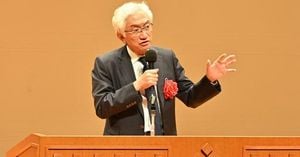In a highly publicized event that drew global attention, former U.S. President Donald Trump attended the funeral of Pope Francis in Vatican City on April 26, 2025. The Pope, who passed away at the age of 88 on April 21 following a stroke that led to heart failure, was memorialized in a ceremony attended by an estimated 400,000 mourners, including world leaders and royals.
However, Trump quickly became the center of controversy due to his choice of attire. Instead of the traditional black suit expected at such a solemn occasion, he opted for a navy-blue suit, which many criticized as a breach of the dress code. Notably, leaders such as Ukrainian President Volodymyr Zelenskyy, Irish President Michael D. Higgins, and British politician Sir Keir Starmer adhered to the expected black attire, making Trump’s outfit stand out even more.
Social media erupted with comments labeling Trump’s choice of clothing as disrespectful. One Twitter user lamented, "What is it with Trump that he did not even have the decency to wear a black tie, never mind he wore a blue suit?" Another added, "According to the dress code required by Vatican officials for Pope Francis' funeral, men were required to wear a dark suit, along with a long black tie. Trump shows up in blue." The sentiment was echoed by many who felt that Trump’s attire was emblematic of his tendency to seek attention, even in situations that call for reverence.
In addition to his unusual clothing choice, Trump faced backlash for his behavior during the funeral service. Eyewitnesses reported seeing him chewing gum and checking his phone, actions that were deemed highly inappropriate for such a significant occasion. One critic stated, "Texting from the front row at a funeral…the ultimate disrespect and rudeness from the President of America." Another user remarked, "Such a douchebag. Wearing blue, not black. On his phone at the Pope's funeral. I'm an atheist, but even I show respect for the dead." These actions further fueled the narrative of Trump as a figure lacking the decorum expected of a former president attending a funeral for a prominent global leader.
While Trump was not the only attendee to wear a navy suit—Prince William was also spotted in a similar outfit—his choice was particularly scrutinized due to the stark contrast with the predominantly black-clad crowd. Many observers expressed disbelief that Trump did not own a black suit suitable for such an occasion, with one user asking, "Why doesn't he wear a proper suit? Zelensky does."
The funeral, which marked a significant moment in the Catholic Church and drew leaders from around the world, was a moment for reflection on Pope Francis's legacy. The Pope had been known for his progressive views and efforts to bridge divides among different faiths and cultures. His final wishes included a simple burial, emphasizing humility and a connection to the Virgin Mary, as he had expressed in his testament. "May the Lord grant a fitting reward to all those who have loved me and who continue to pray for me. The suffering that has marked the final part of my life, I offer to the Lord, for peace in the world and for fraternity among peoples," he stated.
The contrast between the solemnity of the occasion and Trump’s behavior and attire has sparked discussions about respect and decorum in public life. Critics argue that his actions reflect a broader trend of disregard for traditional norms and expectations, especially in contexts that demand humility and respect.
As the world mourns the loss of Pope Francis, the discussions surrounding Trump's attendance at the funeral highlight the complexities of public perception and the expectations placed on political figures during significant global events. The former president's choices have reignited debates about his role in American politics and how he is viewed both domestically and internationally.
In the wake of the funeral, many are left to ponder the implications of such actions by a former president. As the public continues to scrutinize his choices, it raises questions about the responsibilities of leaders to embody the values they espouse, particularly in moments of collective mourning.
Ultimately, the funeral of Pope Francis served not just as a farewell to a beloved leader but also as a stage where the actions of public figures, like Trump, are magnified and critiqued. The global response to these actions reflects a broader societal expectation for respect and dignity in the face of loss, a standard that many felt Trump did not meet.
As discussions surrounding the event continue, it remains clear that the legacy of Pope Francis and the reactions to his passing will resonate far beyond the walls of the Vatican, shaping the narrative of contemporary leadership and public decorum in the years to come.



